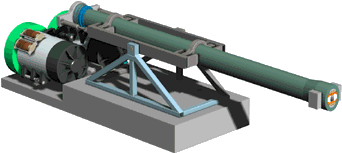An Exploration of the Physics Behind Rail Guns
Daniel Lenord
University of Alaska Fairbanks
Physics 212 Web Project, Spring 2003
Daniel Lenord
University of Alaska Fairbanks
Physics 212 Web Project, Spring 2003
| Index | Introduction | Velocity | Right Hand Rule | Bibliography | |

Electromagnetic Gun
The concept of a rail gun is simple: two parallel bars connected to a power source produce an electric field. This electric field can be used to propel a projectile along the bars. If enough amperage is provided, the projectile can achieve velocities of up to 4 km/s. The U.S. Army has been interested in the potential of electromagnetic guns for quite some time. In 1988 the University of Texas Center for Electromagnetics began work on a 9 MJ range gun, which would be designed to launch 2-4 kg projectiles at velocities of up to 4 km/s. Design features of this range gun included up to 230 MJ stored energy, 6 kV and 3 MA peak output ratings, and a 9 shot repetitive fire capability. In the early 1990's, the U.S. Army, along with the Marine Corps, showed much interest in the Cannon Caliber Electromagnetic Gun System (CCEMG). This project seeks to demonstrate an elecrtomagnetic gun system designed from a system/mission prospective. The CCEMG showed a 3 times increase in energy and power density over the range gun system.
The U.S. Army plans to produce electric tanks by the year 2015 with electromagnetic guns mounted on them. The all-electric tank would include electric vehicle drive and suspension and electric armaments. In this concept, the flywheel energy can be used as a flywheel battery to provide power for vehicle acceleration and regenerative braking, and will also produce electrical power for the electromagnetic armaments. This is the perfect example of how physics is still impacting the world in which we live.